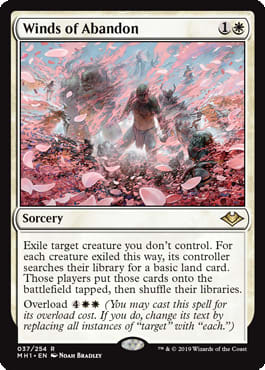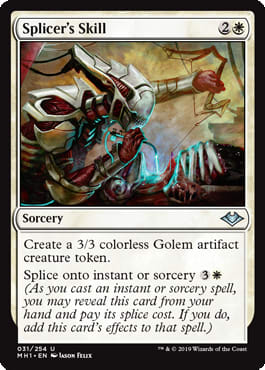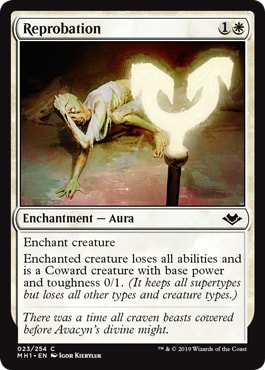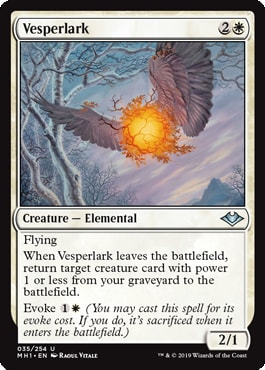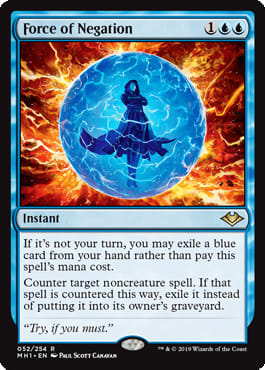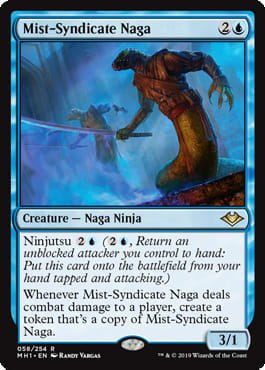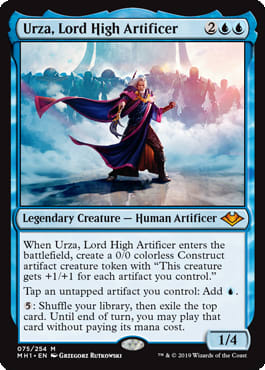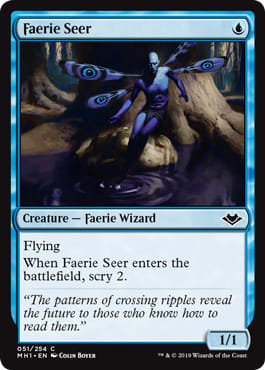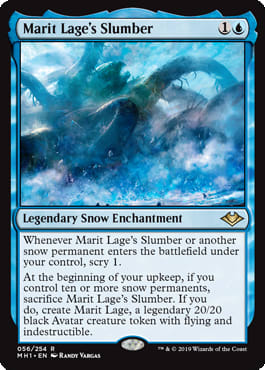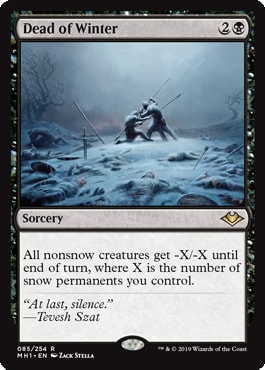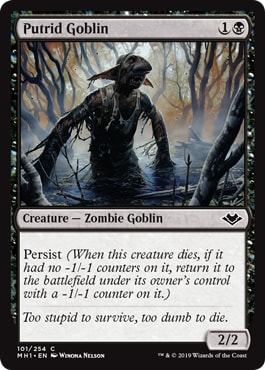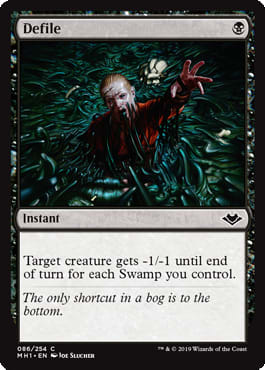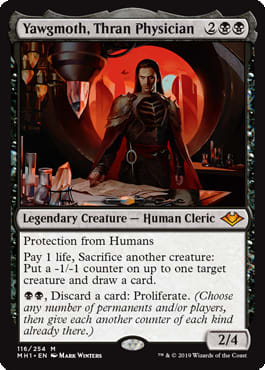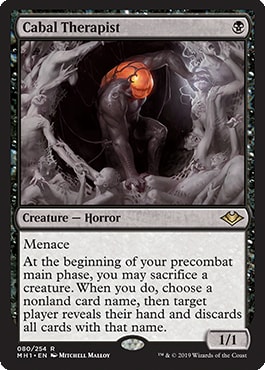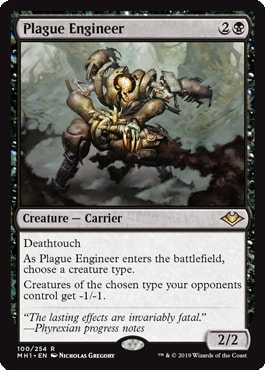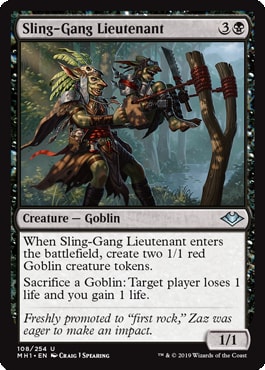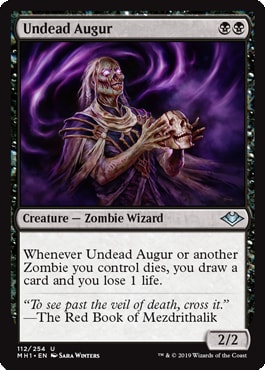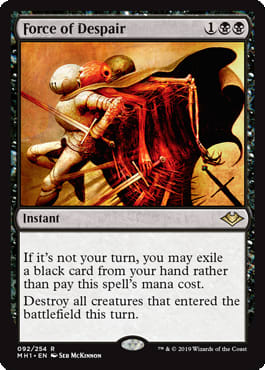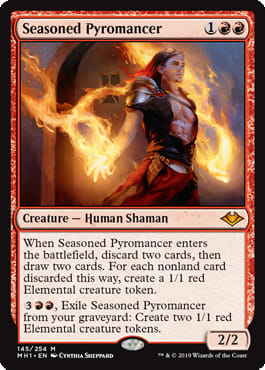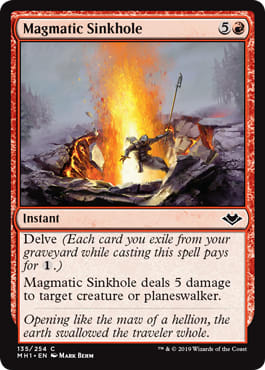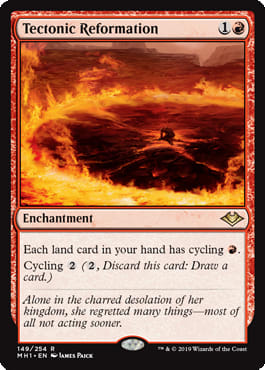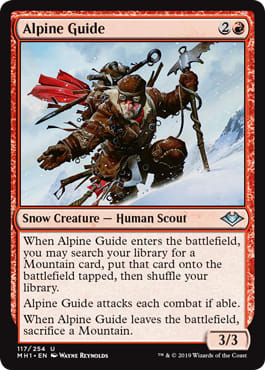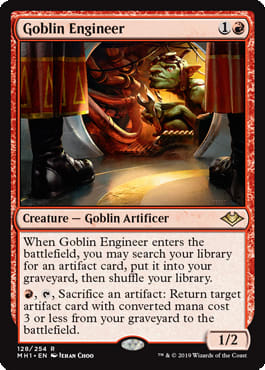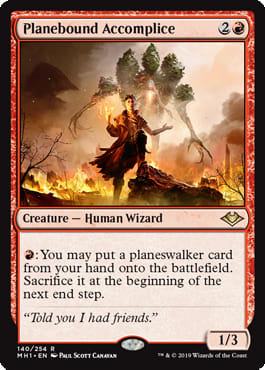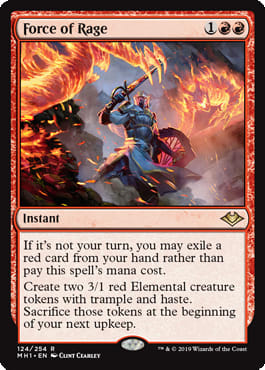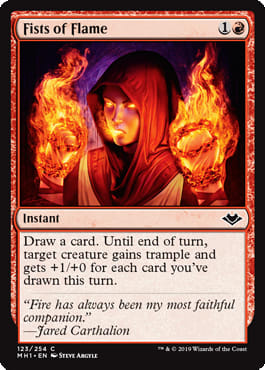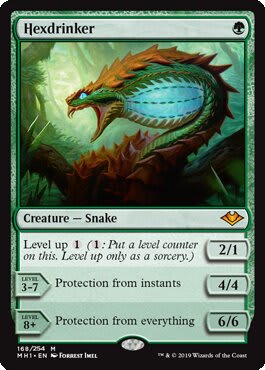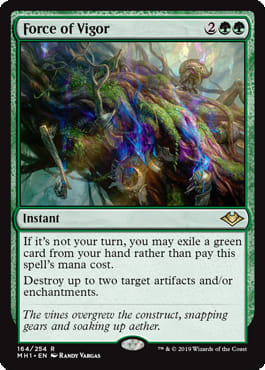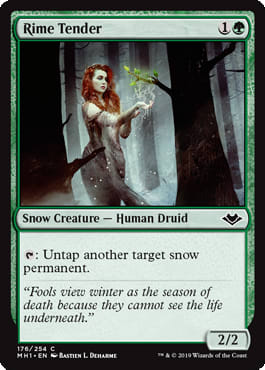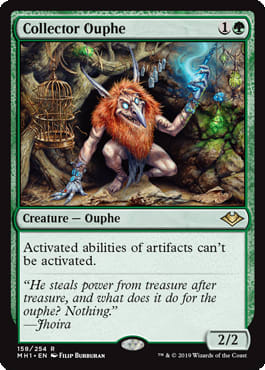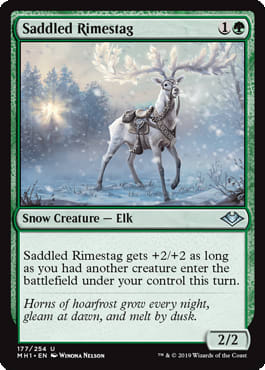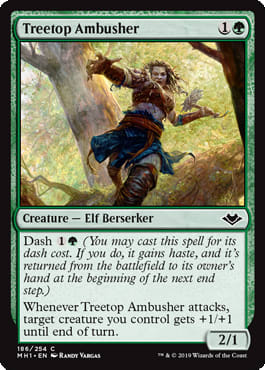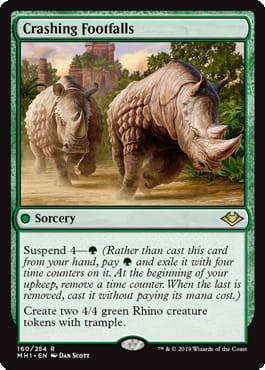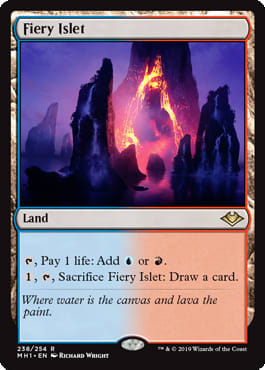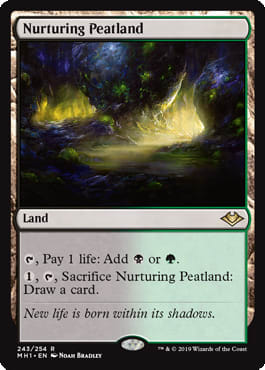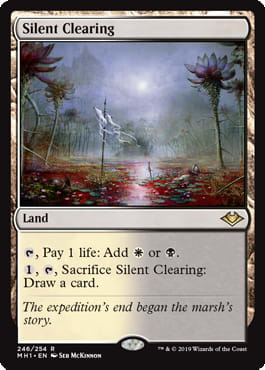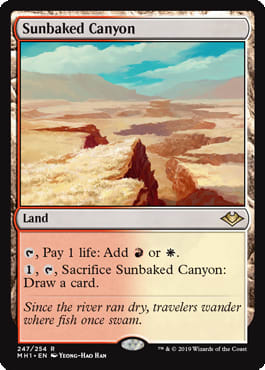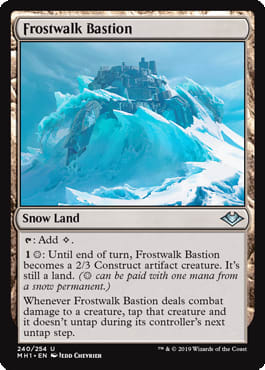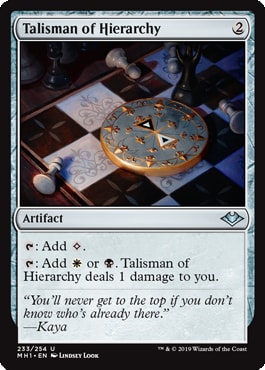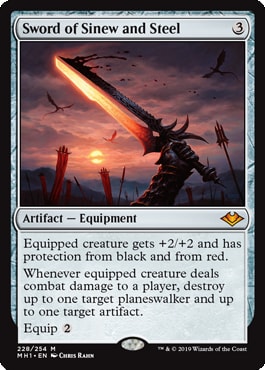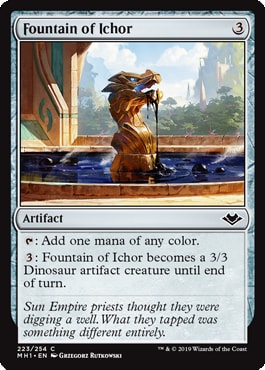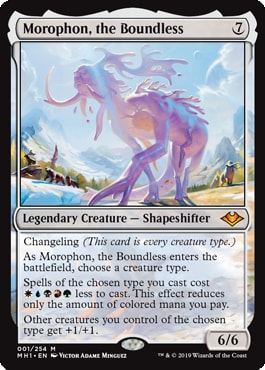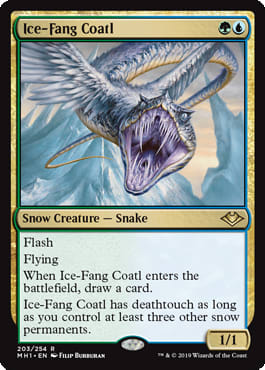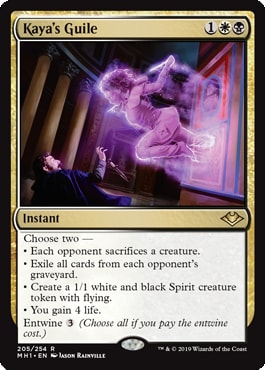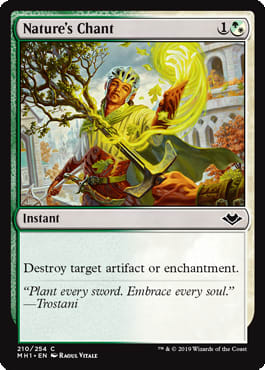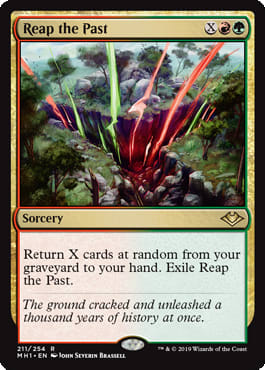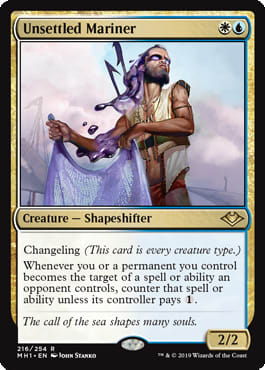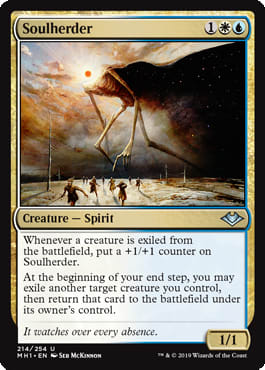Modern Horizons continues the trend of stellar Cube sets, thanks to Play Design's influence.
Of note: these evaluations are based on Cube experience from about 10 Cube drafts in my Cube and SirFunchalot's unpowered Cube, not just outsourced to other formats like people playing the cards on MTGO. This article was written before those events occurred (my editor can back me up on this.) While my Cube is powered, my experiences should can be generalized to yours, provided it does not have unique design restrictions (i.e. pauper or peasant).
As I have in recent reviews, I will reference decks that have used Modern Horizons cards and won/had the best record in Cube drafts. Of course, going 3-0 with a card in a deck isn't ironclad proof of that card being good, but it does help illustrate how the card performs in winning Cube decks.
Cards are sorted in order of approximate interest by color - the ones that piqued my interest for Cube discussed first in approximate order, so don't get too hung up about thinking that one card is strictly better not close, or whatever the kids say these days. If a card isn't discussed here, it's likely that it's not that great for Cubes with rares in them.
Skip to:
White
Serra the Benevolent has more repetitions of testing due to a lengthier period of knowledge of her impending print. Although White has a billion 4-mana planeswalkers, she punches incredibly well within that weight class and arguably beats them all.
Her ultimate making a Worship emblem is not oppressive and typically, instead of going to Turbo Emblem mode, she pops out a Serra Angel, and - if needed to close out the game - eventually creates another one (DJ Khaled). This amount of power is more than good enough for the cost. Despite not being "flashy," just making a Serra Angel to defend herself is great, and vigilance on the tokens is extremely useful to put a clock on the opponent while defending your life total as well as her loyalty (or that of other planeswalkers).
Assuming she's still alive, her token attacks like an Archangel and while it's nice if Serra can pump other fliers, most of the time it usually just says "make your Serra Angels get +1/+1," and the added pressure of a pseudo-anthem justifies her mana investment when compared to other similarly-costed options.
This is an example of meat-and-potatoes decks utilizing her:
Cube Example #1 | Cube | Usman Jamil
- Creatures (9)
- 1 Adanto Vanguard
- 1 Dauntless Bodyguard
- 1 Figure of Destiny
- 1 Isamaru, Hound of Konda
- 1 Leonin Relic-Warder
- 1 Mardu Woe-Reaper
- 1 Mother of Runes
- 1 Snapcaster Mage
- 1 Thraben Inspector
- Planeswalkers (5)
- 1 Gideon Blackblade
- 1 Gideon of the Trials
- 1 Gideon, Ally of Zendikar
- 1 Serra the Benevolent
- 1 Teferi, Time Raveler
- Instants (2)
- 1 Path to Exile
- 1 Remand
- Sorceries (3)
- 1 Armageddon
- 1 Fractured Identity
- 1 Ravages of War
- Enchantments (2)
- 1 GO TO JAIL
- 1 Legion's Landing
- Artifacts (2)
- 1 Heirloom Blade
- 1 Mana Crypt
- Lands (16)
- 11 Plains
- 1 Mishra's Factory
- 1 Plateau
- 1 Scalding Tarn
- 1 Strip Mine
- 1 Volcanic Island
And
Cube Example #2 | Cube | Usman Jamil
- Creatures (6)
- 1 Aurelia, Exemplar of Justice
- 1 Blade Splicer
- 1 Doom Whisperer
- 1 Ophiomancer
- 1 Solemn Simulacrum
- 1 Wurmcoil Engine
- Planeswalkers (8)
- 1 Chandra, Flamecaller
- 1 Chandra, Torch of Defiance
- 1 Daretti, Scrap Savant
- 1 Elspeth, Knight-Errant
- 1 Garruk Relentless
- 1 Gideon, Ally of Zendikar
- 1 Serra the Benevolent
- 1 Ugin, the Spirit Dragon
- Instants (2)
- 1 Go for the Throat
- 1 Path to Exile
- Sorceries (4)
- 1 Balance
- 1 Damnation
- 1 Lingering Souls
- 1 Toxic Deluge
- Enchantments (1)
- 1 Sylvan Library
- Artifacts (4)
- 1 Black Lotus
- 1 Gruul Signet
- 1 Rakdos Signet
- 1 Selesnya Signet
- Lands (15)
- 1 Forest
- 2 Mountain
- 3 Swamp
- 4 Plains
- 1 Ash Barrens
- 1 Godless Shrine
- 1 Lavaclaw Reaches
- 1 Temple Garden
- 1 Windswept Heath
Overall, she is very impressive and may very well be the best Cube card in the set. If you're worried about saturation for White cards at four mana and you're unable to cut something else at four, find something elsewhere, since she's much better than the Angel of Inventions and Baneslayer Angels of the world.
On Thin Ice - As this set's brought on several cards that care about snow, there's more reason to include snow payoff cards by counting your basics as snow. Before Modern Horizons, the payoffs were much worse - considering one of the more commonly used cards was the woefully-outclassed-in-2019 Phyrexian Ironfoot. When I tried snow basics over a decade ago, the payoffs were nice but it wasn't worth the hassle for a few cards.
However, cards like On Thin Ice and others in Modern Horizons are a good payoff to consider the snow inclusion in your Cube. I now have snow basics in my Cube, and this is a draft-winning Cube deck from a recent draft:
Cube Example #3 | Cube | Usman Jamil
- Creatures (15)
- 1 Angel of Sanctions
- 1 Chamber Sentry
- 1 Dauntless Bodyguard
- 1 Deal Broker
- 1 Dread Wanderer
- 1 Giver of Runes
- 1 Guardian of the Guildpact
- 1 Hangarback Walker
- 1 Icehide Golem
- 1 Monastery Mentor
- 1 Ophiomancer
- 1 Ranger-Captain of Eos
- 1 Restoration Angel
- 1 Scrapheap Scrounger
- 1 Thalia, Guardian of Thraben
- Planeswalkers (1)
- 1 Serra the Benevolent
- Instants (2)
- 1 Slaughter Pact
- 1 Unexpectedly Absent
- Sorceries (3)
- 1 Armageddon
- 1 Council's Judgment
- 1 Winds of Abandon
- Enchantments (2)
- 1 Oblivion Ring
- 1 On Thin Ice
- Artifacts (1)
- 1 Heirloom Blade
As you can expect, On Thin Ice is similar to Chained to the Rocks, a highly efficient removal spell that Boros sections no longer have room for due to power creep. Without the much higher barrier to entry of fighting for a Boros slot, On Thin Ice has a much better chance for Cube longevity. White spot removal starts for creatures dips in quality quickly after Swords to Plowshares and Path to Exile, but this is another great addition.
Giver of Runes suffers in comparison to Mother of Runes due to her inability to protect herself, and I find that she has a significantly shorter shelf life than her precursor because the window of opportunity to kill her is "any time" rather than "when she's summoning sick". This difference makes her significantly easier to deal with, but her ability to impact the board makes her closer to a Benevolent Bodyguard or a Dauntless Bodyguard to help protect your higher-costed marquee threats. This Orzhov aggro deck from Sirfunchalot's Cube is a good example of a deck that uses her well:
Cube Example #4 | Cube | Usman Jamil
- Creatures (16)
- 1 Asylum Visitor
- 1 Bloodghast
- 1 Bloodsoaked Champion
- 1 Brain Maggot
- 1 Carnophage
- 1 Gravecrawler
- 1 Icehide Golem
- 1 Kitesail Freebooter
- 1 Mardu Strike Leader
- 1 Mother of Runes
- 1 Putrid Goblin
- 1 Rimebound Dead
- 1 Stoneforge Mystic
- 1 Scrapheap Scrounger
- 1 Tidehollow Sculler
- 1 Undead Augur
- Sorceries (3)
- 1 Ravages of War
- 1 Thoughtseize
- 1 Wrench Mind
- Enchantments (1)
- 1 Genju of the Fens
- Artifacts (3)
- 1 Heirloom Blade
- 1 Sword of Feast and Famine
- 1 Tangle Wire
Overall, she is still a great addition for White aggro decks despite being a significant step lower in power than Mother of Runes. Don't just be lazy and cut another 1-drop for her; your White aggro decks' performance will appreciate it.
Ranger-Captain of Eos is a card that I originally subconsciously compared to Ranger of Eos, a card that has been power crept out of many Cubes. As SirFunchalot points out, though, it is a three mana 3/3 that draws a creature at its very worst. It is important to consider how useful tutoring a creature is as both a means to refuel after wrath or keep the damage train rolling.
Zolthux had a really great comparison for it:
When a card (specifically, a creature with an on rate body) costs three mana, it means it can be played early enough as an aggro card to commit a threat to the board. It can also be accelerated in aggro-midrange as a way to put early pressure. Depending on its utility or ability to scale up, it can also see play in control/combo, but those [types of cards] are more niche.
Ranger-Captain of Eos is an example of this kind of 'link'. A three mana 3/3 is at base rate for a creature that commits pressure to the board, and he comes down early enough that the (presumably) aggressive creature you search up is still relevant to the board state. Even as a top end, playing him as wrath insurance helps you finish the game with your early threats. As a midgame card, he's a fine value engine who puts a body big enough to block aggro creatures, while searching an accelerant or utility creature."
I have yet to see him preemptively prevent a wrath by threatening lethal, but that mode is excellent as it forces your opponent's hand while allowing you to rebuild immediately after. While there exist a ton of great new 3-drops in White, like Gideon Blackblade, Ranger-Captain of Eos complements those strategies well and makes a strong impact in White aggro decks.
Winds of Abandon - While this isn't close to the power level of Path to Exile, I find that even though it is sorcery speed and costs an additional mana, Winds of Abandon is far from bad. The 2nd tier of White removal is welcoming to another tool because there is not a lot of tier-1 White removal, and the function of Winds as a White removal spell with some upside if the game goes long enough remains. My issue with other overload cards like Mizzium Mortars is they barely hit the base rate for what a Cube deck wants, and even then, Red aggro decks aren't enthusiastic to play them.
Overall, I like it better than cards like Journey to Nowhere, which felt like a significant leap in power worse than 1-mana removal in White and even 2-mana removal in Red and Black. Unlike Mizzium Mortars, Winds is fine in any White deck along the spectrum from aggro to control. The deck above utilizes it well but this midrange deck from Sirfunchalot's Cube also uses it effectively, primarily as a ![]()
![]() Path to Exile and occasionally as a blowout in the few times when it overloads. It's obviously not Path or Swords, but it's a great supplement for Cubes to have in their arsenal.
Path to Exile and occasionally as a blowout in the few times when it overloads. It's obviously not Path or Swords, but it's a great supplement for Cubes to have in their arsenal.
Force of Virtue is a card that I like for aggro despite my general distaste for anthems like Honor of the Pure and Intangible Virtue due to the general competitiveness for non-creature slots in aggro decks, an archetype where I generally find equipment to grant more utility.
It's easy to look at a card like Force of Virtue and assume that it's just a card for token decks, but this extremely greedy aggro 3-0 deck utilizes it well:
Cube Example #5 | Cube | Usman Jamil
- Creatures (11)
- 1 Adanto Vanguard
- 1 Figure of Destiny
- 1 Giver of Runes
- 1 Goldmeadow Harrier
- 1 Grim Lavamancer
- 1 Hexdrinker
- 1 Honored Hydra
- 1 Monastery Mentor
- 1 Ranger-Captain of Eos
- 1 Thraben Inspector
- 1 Zurgo Bellstriker
- Planeswalkers (2)
- 1 Ajani, Adversary of Tyrants
- 1 Gideon of the Trials
- Instants (3)
- 1 Burst Lightning
- 1 Force of Vigor
- 1 Unexpectedly Absent
- Sorceries (3)
- 1 Armageddon
- 1 Fractured Identity
- 1 Lingering Souls
- Artifacts (5)
- 1 Jeweled Amulet
- 1 Mox Emerald
- 1 Mox Sapphire
- 1 Sword of Truth and Justice
- 1 Sword of War and Peace
Aside from the busted mana and wanting a few more 2-drops instead of its high end, it's a pretty stock aggro build that doesn't really have a big "token theme" to make use of Force of Virtue. Because it's free and contributes clock, there's an inherent assumption that I've generally seen that you have to cast this on either turn 0 or 1 to emulate a nut draw, but this discounts a lot of its use. Funnily, around the time that it got previewed, I was jamming a bunch of games with a Mono-White aggro deck in Pauper Cube (it may end up in an article someday) with Ramosian Rally, a card that's impressed me in the format and had emulated the "free" ability on Force of Virtue. However, evaluating it only as a free spell and discounting its other uses as a free combat trick or even a combat trick on your own turn to make combat math is something that tends to get ignored, because those modes aren't seen as efficient.
In the last article, I talked about how with flexible cards like Finale of Glory, it's easy to dismiss how useful flexibility is, like if a card has to be cast in a mana-inefficient spot, like casting a Finale of Glory for ![]()
![]()
![]() - since no one really thinks "Oh wow, I'm casting a Vigilant Gray Ogre in Cube, hooray!" but when the time calls for it, it's usually the right call and a positive aspect of flexibility. Much like Gideon Blackblade's various +1 abilities, just about all of the aspects of Force of Virtue have been utilized effectively - a free anthem on the opponent's turn, as a
- since no one really thinks "Oh wow, I'm casting a Vigilant Gray Ogre in Cube, hooray!" but when the time calls for it, it's usually the right call and a positive aspect of flexibility. Much like Gideon Blackblade's various +1 abilities, just about all of the aspects of Force of Virtue have been utilized effectively - a free anthem on the opponent's turn, as a ![]()
![]()
![]() instant speed anthem and even as a
instant speed anthem and even as a ![]()
![]()
![]() anthem on the opponent's turn. While the latter two modes aren't efficiency monsters, they've still been nice modes to have in the toolbelt.
anthem on the opponent's turn. While the latter two modes aren't efficiency monsters, they've still been nice modes to have in the toolbelt.
It's been seeing some play in non-aggro and honestly I don't think it helped those decks, but overall it's just a great tool for White Cube aggro decks. Don't dismiss this because of previous anthems, this is a step above them.
Splicer's Skill is a card that impresses me less over time. It is generally too mana inefficient to add a ![]()
![]() kicker to make a 3/3 on a spell, and while casting it as a
kicker to make a 3/3 on a spell, and while casting it as a ![]()
![]() 3/3 is fine, it's only done if absolutely needs to be. The card is at its best in instant-heavy decks that could use this as the world's clunkiest Wolfir Avenger, and I find those decks just aren't able to utilize the synergy as effectively as predicted. Perhaps its lack of effectiveness shown in the drafts I see it in stems from user error, but in my analysis, I find that Splicer's Skill likely doesn't have a home in Cubes with rares.
3/3 is fine, it's only done if absolutely needs to be. The card is at its best in instant-heavy decks that could use this as the world's clunkiest Wolfir Avenger, and I find those decks just aren't able to utilize the synergy as effectively as predicted. Perhaps its lack of effectiveness shown in the drafts I see it in stems from user error, but in my analysis, I find that Splicer's Skill likely doesn't have a home in Cubes with rares.
Reprobation is fine enough, but is easily overshadowed by On Thin Ice and Winds of Abandon beefing up the 2-drop removal slot. It downgrades a creature and because it leaves something behind, it's less good in aggro. Consider it in your toolbox, but don't be surprised if it just lingers in your Cube sideboard.
Martyr's Soul - doesn't have hope in non-Pauper/Peasant Cubes because other White 3-drops are significantly better, and it's underpowered if not cast for free. There are times where it's right to cast it for ![]()
![]() by tapping another creature to churn out a 3/2, and I find this occurs often in my Pauper Cube. However, friends who tested it in their Cubes report that its above-curve size simply cannot compete with rares.
by tapping another creature to churn out a 3/2, and I find this occurs often in my Pauper Cube. However, friends who tested it in their Cubes report that its above-curve size simply cannot compete with rares.
Vesperlark - is an odd 2/1 flier for three that can bring back a 1-power creature. While it can evoke for a cheap cost, it just doesn't garner enough advantage due to its limited target range. Comparably, Reveillark get back more significant threats (of course, for a noticeable mana upcharge), but being limited to only getting back 1-power things limits the targets to clones and utility 1-drops. Considering how good White 3-drops are now, I find this one to be wholly unimpressive.
Generous Gift is a Beast Within for a color that already has access to Oblivion Ring, Banishing Light and various 4-mana versions like Quarantine Field and the instant speed Cast Out. Beast Within is best used in decks that can ignore the 3/3 it gives the opponent. These decks either place giant monsters in front of the token, or they find that dealing with the game-shaking threat was important enough to downgrade it to a 3/3 - the latter of which is a symptom of Green not having access to a thousand O-Ring variants.
In the War of the Spark Cube review, I speak about how some colors value effects more than others, and how that impacts the context of their power within their respective color:
Consider Harmonize, which is basically Concentrate, and Sunlance, which is Strafe - a card that no one's heard of, for good reason. Consider how much more often these cards see play compared to their normally colored counterparts (if your argument is that you're not playing either, you're missing the point); Harmonize's and Sunlance's effects are more useful in their respective colors than Concentrate and Strafe, cards that are a dime a dozen in their respective colors.
Unfortunately, the context of Generous Gift amongst a sea of O-Rings brings it closer to Strafe than Sunlance. Unless you really need an effect like this in your Cube, don't bother.
Blue
Force of Negation draws obvious comparisons to Force of Will, and had been underrated by many because it doesn't do what Force of Will does - counter anything for free. Even with its restrictions, however, Force of Negation is a solid addition to Blue decks as the "only on your opponent's turn" is typically not a relevant drawback: it is used to proactively counter annoying, opposing threats for free. I'm currently into cards like Spell Pierce as a cheap way to interact with problematic cards with which Doom Blades can't.
As is the case with Force of Virtue, it's easy to discount the use of casting it for retail. Although ![]()
![]()
![]() is overcosted for Negate, holding up three mana for the effect isn't embarrassing and is generally fine as a failsafe. Even if not ideal, the retail side of being a
is overcosted for Negate, holding up three mana for the effect isn't embarrassing and is generally fine as a failsafe. Even if not ideal, the retail side of being a ![]()
![]()
![]() Negate is *significantly* better than the retail side of Force of Will's
Negate is *significantly* better than the retail side of Force of Will's ![]()
![]()
![]() cost, a point that isn't often considered due to focus on the free mode (even if FoW is consistently overrated in Cube). The ability to Negate something tends to be contextually based on the power level of non-creatures spells, since at times, they can be some of the few spells that truly matter in a matchup. Due to the difficulty of interacting with non-creature spells in comparison to creatures, negate-types of counters tend to be pretty close to Counterspell; Blue is often paired with other colors that can deal with creatures outside of the stack. Because creature-based threats are easier to deal with on the board with other removal, your Negate effect typically counters something useful over the course of any given game.
cost, a point that isn't often considered due to focus on the free mode (even if FoW is consistently overrated in Cube). The ability to Negate something tends to be contextually based on the power level of non-creatures spells, since at times, they can be some of the few spells that truly matter in a matchup. Due to the difficulty of interacting with non-creature spells in comparison to creatures, negate-types of counters tend to be pretty close to Counterspell; Blue is often paired with other colors that can deal with creatures outside of the stack. Because creature-based threats are easier to deal with on the board with other removal, your Negate effect typically counters something useful over the course of any given game.
Scour All Possibilities - Blue cantrips and card selection are in a weird space of being subtly powerful and yet generally underrated in Cube. The continual undervaluing of these effects strikes me as odd since Cube essentially create imperfect analogues of Constructed decks, and cantrips/card selection help to smooth draws to help to ensure consistency. Preordain and Ponder are absurd at one mana; is two mana worth it? Yes.
Playing cards like Omen can be a hard pill to swallow, even if they're generally solid for Blue decks, because they compare poorly to cards like Ponder. However, the same could be said of cards like Lightning Strike when compared to Lightning Bolt, a fact SirFunchalot points out as he notes good performance from these cantrips in his Cube. I find that Scour All Possibilities' flashback, even if relatively pricey, makes the pill easier to swallow. Paying ![]()
![]() for a cantrip + library manipulation spell fits the base rate of what Blue decks want to do, especially considering it isn't uncommon for slower Blue decks to flash it back. Similar to Firebolt's flashback cost of
for a cantrip + library manipulation spell fits the base rate of what Blue decks want to do, especially considering it isn't uncommon for slower Blue decks to flash it back. Similar to Firebolt's flashback cost of ![]()
![]() , Scour All Possibilities' flashback cost isn't breaking efficiency records, but it certainly still has utility.
, Scour All Possibilities' flashback cost isn't breaking efficiency records, but it certainly still has utility.
I hear arguments that this is worse than Foresee because it costs ![]()
![]()
![]() to do mostly the same thing as Foresee's
to do mostly the same thing as Foresee's ![]()
![]() or that it's worse than Deep Analysis, but these comparisons miss the point, as Scour All Possibilities's primary function is as a cantrip to set up your next draw and then again to refuel. This is different from the
or that it's worse than Deep Analysis, but these comparisons miss the point, as Scour All Possibilities's primary function is as a cantrip to set up your next draw and then again to refuel. This is different from the ![]()
![]() draw spell's brute force card advantage. It's similar to saying Firebolt does a bad impression of Pyrotechnics, as saying so discounts Firebolt's primary function - cheap removal that can be flashed back later, if need be.
draw spell's brute force card advantage. It's similar to saying Firebolt does a bad impression of Pyrotechnics, as saying so discounts Firebolt's primary function - cheap removal that can be flashed back later, if need be.
While I have yet to take the plunge to play cards like Omen, this may be an introductory course much like how Law-Rune Enforcer (hopefully) was for introducing 1-mana tappers to non-Pauper Cubes. If you initially discounted Scour All Possibilities, you'll be pleasantly surprised at how it actually plays out.
Tribute Mage draws comparisons between trinket, trophy and treasure mage for target numbers and marquee targets, so let's check out how they compare:
Trinket: Power 9, Everflowing Chalice, Bonesplitter, Sensei's Divining Top, Skullclamp, Sol Ring, Bomat Courier, Hangarback Walker, Walking Ballista (17)
Tribute: All of the Signets and Talismans, Lightning Greaves, Mind Stone, Smuggler's Copter, Winter Orb, Phyrexian Revoker, Spellskite, Umezawa's Jitte, Scrapheap Scrounger (28, if all signets and talismans, but likely closer to 20)
Trophy: Basalt Monolith, Chromatic Lantern, Coalition Relic, Grafted Wargear, all of the Swords, Worn Powerstone (10, not counting the 2 new swords)
(Treasure Mage is significantly worse than the previous 3.)
Numbers don't tell the entire tale, as a Trinket Mage getting a Mox or a Sol Ring doesn't fit the same function as getting a Sword from a Trophy Mage, and for the most part, these tutors on a creature tend to require the following to make the final 40 of a deck:
- A busted card to tutor for, so that it can act as a virtual second copy (a mox on turn three isn't as good, of course, but generally it's still fine to tutor for.)
- A robust toolbox that rewards flexibility in lieu of raw power.
In terms of 2-drops, there are only a few busted targets like Winter Orb, Umezawa's Jitte and arguably Smuggler's Copter, complemented with a lot of solid Mana rocks, as even Grim Monolith tends to not be as absurd on turn four unless setting up something like a storm kill or a similar bursty win. Because of this, Trophy Mage's targets tend to be workhorse cards like Swords. Thus, Tribute Mage and Trophy Mage usually tend to be more of the latter style tutor, whereas Trinket Mage tends to be the former in Cubes with power and the latter without. Note that these are general cases, and ultimately the toolbox style depends on what you have available in the pool and what you end up taking.
So where does Tribute Mage rank in terms of mages?
Swords aren't Mana rocks and the deck that wants one typically doesn't want the other.
I know that in this day and age people want some kind of definitive spoon-fed answer but reality just doesn't work that way and each mage helps different decks differently. Is Inferno Titan better than Firebolt? I have no idea because their roles are so different. Despite the mages having the same stats and casting cost, they're quite different in their applications, as well. Inclusion in your Cube mainly depends on which type of deck you want to provide more support.
Watcher for Tomorrow - entering the battlefield tapped means that it can't just throw itself under the bus to Impulse, but that doesn't mean that it's bad, or necessarily worse than something more straightforward than Wall of Blossoms or Fblthp, the Lost as these analyses ignore that those cards don't give card selection. Discounting this due to the fact that it doesn't just draw a card when it enters the battlefield ignores its role in gameplay: being a body that can trade up with 2/2s much easier and get in chip shots against opposing walkers, which is different from the aforementioned options. It's still a card that Blue control decks want, but leans more aggressively than either Wall of Omens or Fibbles. Because of this, I've found this to still be a solid performer for all stripes of Blue decks.
Mist-Syndicate Naga is a card that, like Watcher for Tomorrow, supports non-control decks because its primary value is in a raw statline that gets better with additional creatures, neither of which are things in which Blue control decks generally hold interest. Similarly to Watcher, it's a great addition for more attack-oriented Blue decks.
While Red has five Rabblemaster variants and White has Brimaz, King of Oreskos and, to an extent, Precinct Captain, other colors don't get access to these big snowballing threats. Blue's closest analog is Wake Thrasher, but as a big threat, Mist-Syndicate Naga fits that role better.
Mist-Syndicate Naga runs away quickly with the game if the opponent can't deal with them, and generally that point of no return happens if there's two of them, similar to how Najeela, the Blade-Blossom starts to run away with the game if she's able to attack. This Jeskai tempo deck from SirFunchalot's Cube had the Naga work very well and end the game in a quick fashion when ninjutsued out:
Cube Example #6 | Cube | Usman Jamil
- Creatures (9)
- 1 Hanweir Garrison
- 1 Kari Zev, Skyship Raider
- 1 Krenko, Tin Street Kingpin
- 1 Mist-Syndicate Naga
- 1 Rekindling Phoenix
- 1 Snapcaster Mage
- 1 Stalking Yeti
- 1 Watcher for Tomorrow
- 1 Young Pyromancer
- Planeswalkers (1)
- 1 Sarkhan the Masterless
- Instants (9)
- 1 Abrade
- 1 Brainstorm
- 1 Broken Ambitions
- 1 Burst Lightning
- 1 Impulse
- 1 Lightning Strike
- 1 Negate
- 1 Revolutionary Rebuff
- 1 Telling Time
- Sorceries (4)
- 1 Omen
- 1 Scour All Possibilities
- 1 See Beyond
- 1 Sleight of Hand
- Artifacts (1)
- 1 Sword of Fire and Ice
These kinds of Blue cards have to be extremely powerful to justify the relatively smaller % of decks that want cards like this, and Mist-Syndicate Naga delivers.
Winter's Rest is Blue's analog to Pacifism, mostly considered for Cube because Blue doesn't have access to all of the great spot removal that Black, Red and White have. Generally, Winter's Rest neutralizes a creature, but since some creatures still have static, triggered and non-tapping activated abilities, it doesn't stop all creatures. Again, referring again to the CubeTutor 450-card average, the list isn't as long as one would think with only about 50 hits, ranging from targets like Hellrider to Goblin Cratermaker and Avenger of Zendikar.
Note that hitting a Mulldrifter isn't great even with something like a Doom Blade, but such types of cards are noted here for completion. When Sirfunchalot and I tried it in our respective Cubes, we found that it was pretty much acted as a Blue Journey to Nowhere for Blue decks.
Consider inclusion if your Blue decks want one in their arsenal.
Urza, Lord High Artificer is yet another sorcery speed 4-mana threat that somewhat costs three since he can make a mana with his Karnstruct, but I find that doesn't really matter unless you're casting it on turn five to keep up two mana. Even with the increased artifact count that I have, he is overall just fine. He appears in this 3-0 deck, and while this deck didn't have a high artifact count, I note that if the Karnstruct was a 3/3 instead of a 1/1, the result would not change in most scenarios.
Cube Example #7 | Cube | Usman Jamil
- Creatures (5)
- 1 Man-o'-War
- 1 Sower of Temptation
- 1 Torrential Gearhulk
- 1 Seasoned Pyromancer
- 1 Urza, Lord High Artificer
- Instants (10)
- 1 Archmage's Charm
- 1 Commence the Endgame
- 1 Daze
- 1 Fact or Fiction
- 1 Force of Will
- 1 Magma Jet
- 1 Mana Drain
- 1 Mana Leak
- 1 Mystic Confluence
- 1 Remand
- Sorceries (4)
- 1 Callous Dismissal
- 1 Scour All Possibilities
- 1 Tinker
- 1 Upheaval
- Artifacts (4)
- 1 Boros Signet
- 1 Grim Monolith
- 1 Mana Vault
- 1 Vedalken Shackles
- Lands (17)
- 12 Island
- 4 Mountain
- 1 Gemstone Mine
His Temporal Aperture mode doesn't get around timing restrictions, so it put the caster in an awkward position where it was mainly used if the Urza player had a ton of mana lying fallow to spin the wheel, so it is mostly a wash. The ability to tap artifacts for mana is primarily without use unless it taps an artifact creature for whatever reason.
I'd much rather have something like Kasmina, Enigmatic Mentor and Jace, Wielder of Mysteries than this as a sorcery speed threat. If you include this in your Cube, don't be surprised if you replace it within a year.
Faerie Seer - Gavin's article on the "1 drops are bad in limited" trope talks about when that adage is true and false. This is one of the better 1s in Blue because it has an immediate impact, gets in chip damage and can defend the fort decently. It's a stretch to call this a Wall of Omens, and it really isn't one; it's closer to Omenspeaker, but for one mana (and with evasion), it's worth it. If you've emptied the well for good cantrips, try this out.
Archmage's Charm - is a solid flex card that generally either counters something or draws two cards. The ability to steal something is kind of a backup mode. Its triple-Blue cost severely limits the decks that want it, and - compared to something like Supreme Will that fills a similar role of providing either card selection or countermagic to be able to dig while constrained on mana - it's a little worse. It's odd because it's objectively a fine card, but there exist multitudinous cards that fit what Blue control wants more.
Bazaar Trademage's issue is that it generally doesn't do what Blue decks want to do by putting you down on cards. The argument that the body itself is analogous to a drawn card does make some sense, but that argument only really applies if the Blue deck is in the market for a big Blue flying body. It's not that great in reanimator because the timing window is odd, as the huge creature either needs to be in hand on etb or has to be drawn in the next two cards. This just isn't worth it.
Echo of Eons - when even my friends who love combo like SirFunchalot are cool on this, I find myself a little wary. This card suffers from similar issues to those of Deep Analysis; you have to either:
- Power through an overcosted spell for a good one, much like how you powered through Mother! for its third act or powering through your brussel sprouts* to get to dessert when you were a kid.
- Utilize the ability to put it into the graveyard so that it can be used as a resource for cards like Faithless Looting while still being a Timetwister.
However, it's still just too many hoops to go through for something so mediocre. The original Timetwister and Time Spiral were fine because at least the former is somewhat cheap in mana cost and the latter is essentially free. Unless you're going Mariana Trench levels of deep on storm in your Cube, don't bother.
Marit Lage's Slumber requires too many lands (9 snow basics!), as there aren't a lot of snow cards (Coldsteel Heart) to reliably reduce the number down to something achievable in most decks. Does Marit Lage's Slumber get there as a store brand Search for Azcanta? Not really, since it's unreliable on that front as well. Pass on this.
Mirrodin Besieged - fares poorly because its first ability mirrors Sai, Master Thopterist without being a creature and the latter ability is almost impossible to achieve in almost all Cubes. Don't bother.
Black
Dead of Winter is one of the better snow payoff cards as a mini-wrath. Though it appears similar to Drown in Sorrow or Cry of the Carnarium, I find its ability to scale up over the course of the game helps it perform significantly better than those small wraths. The deck above featuring On Thin Ice sides into more removal and Dead of Winter, and it's one of the better cards in the deck because it is able to function as an undercosted Languish at minimum. Despite its inability to kill spaghetti monsters as Toxic Deluge does, it is able to deal with most board states. It is worse in decks with greedier mana bases, but that is hardly a significant drawback to its power: acting as a better alternative to things like Night Incarnate.
Ransack the Lab - Earlier in this article, I speak about colorshifted effects and how the color's differences can result in contextual differences in how the cards play out. It's easy to discount Ransack the Lab because it's a colorshifted Strategic Planning, a card seldom seen in Cube. Ransack, however, is in a color that utilizes the graveyard more heavily as an active resource. This makes it a great performer, as Sirfunchalot states it is unsurprisingly absurd in this 4-0 Sultai Reanimator deck:
Black's dearth of good cheap card draw outside of Night's Whisper, and (arguably) Sign in Blood make this a great add to Black sections. Give this a whirl.
Putrid Goblin - Safehold Elite doesn't see a lot of Cube play due to putting multicolored and hybrid in the same section, despite one being a drawback and one being a hybrid, causing cards like this to fall through the cracks. Safehold Elite has been a solid performer as a threat that has some longevity to fight through removal that can stymie aggro decks, and Putrid Goblin does the same. Persistent threats do a great job of helping shore up the weakness to spot and mass removal that aggro decks can have, and if you're looking to beef up your Black aggro section instead of just writing it off, Putrid Goblin's a great option to have in your 2-drop slot, especially since it's anemic for Black.
Defile - 1-mana removal in Black has always been wonky and while there's several good free Black removal spells (Snuff Out, Slaughter Pact... kinda), 1-mana Black removals have been awkward. Fatal Push is an archetypical example of a card that's an efficient removal spell but not an effective one.
Generally these kinds of "swamps matters" cards are traps in Cube, since the payoffs just aren't very good like the infamous Indiana Jones scene.
This may *look* like it *needs* to be used in a Mono-Black deck - since that's where it shines the brightest, but it's just solid in other decks.
Think back to the base rate points that I've talked about before. -1/-1 isn't great but once it is able to give something -2/-2, it fits the base mode well and just scales up over the course of the game. It's similar to Skred with snow basics, but slightly worse since there are typically more (snow) basics in a deck than swamps unless either heavy or Mono-Black. Even as an Ulcerate that doesn't dome you, it's still fine.
The payoffs are much higher for those cards to be in their respective lane, but the point of this analogy is that these cards don't *require* explicit support and perfect-case support, as they're fine without optimal support structures. Same with Defile, as it's fine as a -2/-2 effect and just scales up from there. As another late preview, I haven't gotten many reps in with this but it is a better card than people think.
Yawgmoth, Thran Physician is a card that I've been cooler on than many. He has no immediate impact and needs other moving parts to do his thing. At least he sacrifices other creatures that are on the way to the graveyard without requiring mana, which is a huge boon in his favor. Proliferating is nice and synergizes with his Scar ability, but, as I mention in the War of the Spark review, proliferate needs to be on something good on its own to find its way in Cube. Repeatable proliferate lets him shove all-in if there's a planeswalker that's close to ultimate but I have yet to witness it.
Overall hype on him is high and I wish he were better than he is, but I do not see him living up to the excitement.
Mind Rake is a mix between Chain of Smog (an underrated Cube card) and more traditional discard. Its best home is in reanimator and aggro decks that want to dump their hand and/or put cards like Bloodghast into the graveyard, although the overload's benefit is mitigated once the later stage of the game is reached. Currently underrated, but not essential as a disruptive tool.
Endling is yet another value 4-drop for Black midrange decks. Like the other various members of the 'ling cycle, Endling escapes death via removal but only once. I've unfortunately not had many reps with it, but I'm been cooler on it than others.
Cabal Therapist - was another early preview and a card that wasn't as easy to grok. Card is either mediocre or, with additional help, very good. Additional help typically came in the form of other hand peek via other targeted discard or expendable bodies ,so sacrificing a creature wasn't as rough once it gets a peek. Typically, the opponent is on a clock to either cast the revealed non-land or lose it, and if Therapist is able to get a steady stream of fodder, it becomes quite annoying. Obviously, waiting until next turn meant it had to be more of a long term investment that could get in chip shots in the early game rather than having immediate impact, which plays differently than traditional discard.
As cliche as it is to say, in decks that have a lot of sacrifice fodder and/or other targeted discard and are in the market for an early drop, it's great. Inclusion mainly depends on how often those types of aggro decks manifest.
Plague Engineer plays decently since I've found that it almost always has at least some board impact, depending on the matchup. Even though in games 2 and 3, it's easier to figure out what tribe is best to name, its impact was too variant for my liking.
Sling-Gang Lieutenant is fine to gum up the board and usually at least pings something since the ability to sacrifice other goblins for free. Generally, that means that those tokens are on blocking duty. Overall, I just find Black's other 4-drops to be better.
Undead Augur - even as just a standalone effect, Augur doesn't do enough as it doesn't impact the board. It's counterintuitive to think that this is mediocre while Putrid Goblin is great, but adding a 1/1 on board helps to keep beatdown going. Unfortunately, this is a disappointment.
Force of Despair - Earlier in this article I talk about several good free Black removal spells in Cube and don't mention Force. That is intentional because this isn't very good. Only being able to be used as a Cradle to Grave makes it fail the "base rate" mode due to the narrow timing window. If this were a Terror variant, it'd be good. Unfortunately, that's not the reality we live in, and Force of Despair is just a weak Cube card.
Red
Seasoned Pyromancer is yet another good Red 3-drop that suits Red decks well: it draws cards when hellbent. I find people are hesitant to discard cards with Seasoned Pyromancer due to fear of losing value, but thinking of the discards as Memnites helps with that hesitation. The ability to pitch useless lands to find gas has been useful for all kinds of Red decks. Cashing it in for a few elementals, while appearing mana-inefficient, is still useful; much like flashing back Firebolt, it's great in the late game when you have nothing better to do. Overall, it's a great performer and a welcome addition to all Red decks.
Magmatic Sinkhole initially looked awful because it couldn't go face, but Metallix87's comparisons to Hero's Downfall is closer to how it plays out. While I lamented its inability to kill 6-toughness creatures originally, looking at the numbers of the CubeTutor 450 average reveals that to be mental barrier, unreflective of the card's performance:
Sun Titan, Torrential Gearhulk, Frost Titan, Consecrated Sphinx, Grave Titan, Sheoldred, Whispering One, Ob Nixilis Reignited (survives if he +1s), Inferno Titan, Polukranos, World Eater (can evade death via monstrous), Primeval Titan, Woodfall Primus, Wurmcoil Engine
(12)
Looking at the rest, there's not a lot else that survives a hit from this either.
Elesh Norn, Grand Cenobite, Gideon Jura, Griselbrand, Terastodon, Myr Battlesphere, Sundering Titan
Emrakul, the Promised End (can't touch it regardless)
Ulamog, the Ceaseless Hunger (almost all spot removal can't remove this either)
Inkwell Leviathan (spot removal spell can't touch anyway)
Karn Liberated, Ugin, the Spirit Dragon
(11)
So 23 survive, when 177 would fall.
It generally costs around two mana on cast because Red usually doesn't hit the diminishing returns on graveyard use that colors like Blue and Black can (because those colors utilize the graveyard as a resource more frequently). While it is a Red spell that doesn't go face, if you want a Red Hero's Downfall, it's quite good.
Shenanigans - In artifact matchups, the choice to choose is great. Sorcery speed is rough, but the effect is absurd if the opponent has multiple effects; and it can deter the opponent from casting artifacts, or at least make them useless because you can always draw the removal. Overall, it's been a solid addition for Red decks.
Tectonic Reformation was a late preview that looks like another kind of card like Experimental Frenzy by being able to mitigate dead draws and more easily "go off" in Red aggro. One of the things that piqued my interest was that a lot of the Elkin Bottle style draw like Experimental Frenzy and Chandra, Pyromaster end up putting lands in their owner's hand due to providing the ability to draw lands.
This 3-0 deck had it in the sideboard and it was mostly not as good as a generic Red aggro slot, like a Risk Factor or another burn spell.
Cube Example #8 | Cube | Usman Jamil
- Creatures (11)
- 1 Bloodsoaked Champion
- 1 Burning-Tree Emissary
- 1 Figure of Destiny
- 1 Firedrinker Satyr
- 1 Gnarled Scarhide
- 1 Goblin Guide
- 1 Goblin Rabblemaster
- 1 Graveyard Marshal
- 1 Grim Lavamancer
- 1 Krenko, Tin Street Kingpin
- 1 Monastery Swiftspear
- Planeswalkers (2)
- 1 Chandra, Torch of Defiance
- 1 Sarkhan the Masterless
- Instants (4)
- 1 Kolaghan's Command
- 1 Lightning Bolt
- 1 Magmatic Sinkhole
- 1 Searing Spear
- Sorceries (4)
- 1 Arc Trail
- 1 Demonic Tutor
- 1 Fiery Confluence
- 1 Thoughtseize
- Enchantments (1)
- 1 Sulfuric Vortex
- Artifacts (4)
- 1 Black Lotus
- 1 Mana Crypt
- 1 Mox Ruby
- 1 Smuggler's Copter
Alpine Guide is a 3/3 that ramps and color fixes in a color that doesn't get much access to ramp and isn't that bad even it dies when getting a dual land, since your mana's still better than before. Is there much else to say? It's worse than the Rabblemaster variants in aggro, but better in non-aggro, so include accordingly.
Orcish Hellraiser is a filler 2-drop creature that's not bad as a support card. It tends to support more streamlined aggro decks since they can still vomit out several 1-drops through the Echo cost. It's a nombo with the various Rabblemaster variants but still a fine option.
Goblin Engineer - is more of an Entomb with a much lower selection pool, since some of the giant robots that get reanimated like Blightsteel Colossus get automatically shuffled back into the library but a decent number stay in the graveyard (Sphinx of the Steel Wind, Wurmcoil Engine, Myr Battlesphere, etc). Goblin Engineer is a little lackluster in my experience, and the dream scenario of welding something like a Winter Orb or a Tangle Wire is not something that occurs often it usually dies before it can activate. Consider if you want another Entomb for your ![]()
![]() -having reanimator decks.
-having reanimator decks.
Goblin Oriflamme is a better Honor of the Pure since it pumps what matters most for aggro - its clock. Overall, it is a fine performer but is worse than any Searing Spear variant: the rate of return on damage generally isn't as good as a good ol' reliable burn spell.
Planebound Accomplice suffers because it's difficult to load a deck with high cost walkers, and it just doesn't have the support to get there in Cube. There are simply too few planeswalkers to warrant playing this in a deck. In my experience, no one plays it, and, from my analysis, it isn't due to subpar deck construction. Poor poor Milhouse. (Credit to Zolthux's MTG Meme Stash page)
Force of Rage is a card that I tried and really wanted to like. Unfortunately, it isn't very good. It is, essentially, an easier-to-cast Ball Lightning, but in a world with *5* highly efficient Goblin Rabblemaster variants, Mizzium Tank and Seasoned Pyromancer, even Imperial Recruiter as a utility creature, and raw damage sources like Risk Factor and Sulfuric Vortex, there just isn't enough room in many Cubes. Even without considering its competition... it just isn't good enough. Its free ability is *rarely* used, but understandably, it can't just be a Red "White Lightning". It simply underperforms in Red Cube decks of any type.
Fists of Flame is better than people think, but not objectively better than the plethora of other burn spells, making it a tough sell. It is a fine card since it does so much: draws a card, gives a creature +2/+0 and trample until end of turn; it contributes to the Red aggro plan by pushing forward damage and acting as a combat trick that isn't just blown out by instant speed removal (it's still painful, but at least you draw a card.)
Goblin Champion - even for pauper Cubes that lack in depth of good 1-drops (the backbone of aggro) - this ain't it chief. It attacks for one and helps single attackers, but that isn't enough to serve Red's attack plans.
Green
Hexdrinker is more of a ![]()
![]() 4/4 with protection from instants that acts like a small Progenitus, rather than a 2/1 for
4/4 with protection from instants that acts like a small Progenitus, rather than a 2/1 for ![]() , making it a card that fits Green midrange decks like a glove, despite *looking* like an aggro-only card. It's as a mana sink, especially if the opponent taps low.
, making it a card that fits Green midrange decks like a glove, despite *looking* like an aggro-only card. It's as a mana sink, especially if the opponent taps low.
Despite its narrow appearance, Hexdrinker is a great virtual 4-drop for Green decks and is a powerful card for all types of proactive Green decks. Even if you don't care about Green aggro, this is perfectly fine as just a midrange creature. An easy include for Cubes that want some more Green beef for aggro and midrange.
Deep Forest Hermit is the new riff on Deranged Hermit, a card that I find has aged poorly because paying the echo cost safely mandates a lack of opposing removal and/or complacency in having four squirrels on board. Typically, Deranged Hermit manifests in either Green midrange or Opposition, but I find it so vulnerable that I generally equate casting Deranged Hermit on turn five and paying echo (and watching it die) to a good game. Deep Forest Hermit gets around this by being able to stick around without loss of tempo from an echo cost. Vanishing 3 means that he can attack with his four 2/2s twice, which is enough turns to have a good rate of ROI for five mana. Overall, it's an above-average sorcery-speed 5-drop in Green.
Force of Vigor overperforms in my Cube as a dual Disenchant, which admittedly may be biased by my Cube's higher-than-normal artifact count and thus, YMMV. Even when it only Disenchants one target, that is usually enough. It doesn't get cast as a ![]()
![]()
![]() card very often like Force of Virtue, but it makes up for its weakness in matchups where the opponent doesn't have as many targets by being a free-cost blowout in other matchups. Its inclusion mainly depends on how much artifact (and enchantment) hate your Cube is in the market for, but it impresses me more than standbys like Naturalize.
card very often like Force of Virtue, but it makes up for its weakness in matchups where the opponent doesn't have as many targets by being a free-cost blowout in other matchups. Its inclusion mainly depends on how much artifact (and enchantment) hate your Cube is in the market for, but it impresses me more than standbys like Naturalize.
Trumpeting Herd is a pretty innocuous-looking card that seems to have gotten very little attention for Cube since it isn't as flashy as other 4-drops.
My friends Zolthux, SirFunchalot and Buildingadeck have been experimenting with using more proactive Green threats that don't get hosed by spot removal like a lot of traditional Green threats with cards like Wolfir Avenger, Call of the Herd, and Beast Attack, and they report success with this shift.
Earlier in this article, I state how Hexdrinker is a great 4-drop. This fits that same mold well by creating six power for four mana over two bodies and providing an efficient ROI. I feel like it doesn't get the attention it deserves because creating Hill Giants looks unimpressive, but it plays well with the game plan of Green midrange - create threats that pound the opponent into dust that don't just get owned by spot removal. Countering the spell does stop rebound, but your threat base should be diverse enough to play around this weakness if you think the opponent's holding a counterspell up.
Sirfunchalot had this rock solid Green deck with Trumpeting Herd as an impressive pile of stats.
Cube Example #9 | Cube | Usman Jamil
- Creatures (12)
- 1 Birds of Paradise
- 1 Boreal Druid
- 1 Courser of Kruphix
- 1 Deadbridge Goliath
- 1 Deep Forest Hermit
- 1 Elvish Mystic
- 1 Honored Hydra
- 1 Joraga Treespeaker
- 1 Noble Hierarch
- 1 Rofellos, Llanowar Emissary
- 1 Sakura-Tribe Elder
- 1 Tireless Tracker
- Planeswalkers (5)
- 1 Ajani, Adversary of Tyrants
- 1 Ajani, the Greathearted
- 1 Garruk, Primal Hunter
- 1 Garruk Wildspeaker
- 1 Nissa, Voice of Zendikar
- Instants (2)
- 1 Beast Attack
- 1 Fated Intervention
- Sorceries (4)
- 1 Call of the Herd
- 1 Into the North
- 1 Trumpeting Herd
- 1 Winds of Abandon
- Enchantments (3)
- 1 Genju of the Cedars
- 1 Oblivion Ring
- 1 On Thin Ice
- Lands (14)
- 1 Arid Mesa
- 1 Taiga
- 1 Windswept Heath
- 1 Wooded Foothills
- 3 Savannah
- 2 Snow-Covered Plains
- 5 Snow-Covered Forest
Even if you're not on the unga bunga Green resilient threat train, much like Law-Rune Enforcer, this may make you a believer. Just as having a strong cadre of 1-drops for White helps White aggro performance, these elephants help Green midrange decks overcome their general weaknesses.
Rime Tender - is another card that's not going to pull you into making the snow plunge but is a nice card once you commit. As a mostly Incubation Druid style mana producer with a decent 2/2 body, it's a solid card for Green decks to be able to ramp into their higher cost threats. Hardly essential, but it often makes the final 40 of your Green decks with snow basics.
Collector Ouphe - being on a creature helps to get around issues where it's useless, because even though it opens itself up to removal, it at least possesses some form of board presence, like Ramunap Excavator to Crucible of Worlds or Thalia, Guardian of Thraben to Thorn of Amethyst. Having a literal Grizzly Bears body isn't great, but the Blind Phantasm and Youthful Knight bodies on the other creatures aren't breaking efficiency records either, and helps to make up for scenarios when the opponent has nothing that you care about. As another relatively late preview, I haven't had a lot of reps with this but it piques my interest as a piece of hate.
Mother Bear helps Green midrange by being a small threat that comes back, ala a lot of Embalm and Eternalize creatures. She takes dying for her to pay off and being sorcery speed is annoying, but it really just means that you're casting another creature spell, this time from the graveyard. Overall, pretty decent but hardly a top-tier 2-drop.
Saddled Rimestag and Treetop Ambusher have rock-solid stats for aggressive Green decks, making them easy includes if you have Green aggro and easy dismissals if not (they're not great outside of aggro). Noshadowkick1 put it well when he said that if a card like Saddled Rimestag was in a more aggressive color, it'd be included in most Cubes, but unfortunately, that's not the reality in which we live.
Winding Way - generally, these kinds of cards that look at the top X cards of the library that fit criteria aren't that great in Cube (Augur of Bolas) due to Cube decks being imperfect analogues of Constructed archetypes, with the exception being cards that give you several cracks at it, like Azcanta, the Sunken Ruin and Narset, Parter of Veils. Digging four deep makes it so that it generally hits about two lands which is where its primary use lies, with hitting creatures being secondary since most Green decks, while packing creatures, generally don't have as many creatures as lands. It is nice to have that option when your deck is in topdeck mode, but it's still too inconsistent for my liking.
Springbloom Druid has a somewhat Harrow-like effect but it's in reality closer to a slightly better Farhaven Elf as the lands enter the battlefield tapped. Don't play this.
Llanowar Tribe suffers because the 3/3 body isn't super relevant and the cost is subpar at ![]()
![]()
![]() . Though Green can more feasibly get three mana, it's not worth it. This isn't better than Somberwald Sage or even Fyndhorn Elder.
. Though Green can more feasibly get three mana, it's not worth it. This isn't better than Somberwald Sage or even Fyndhorn Elder.
Crashing Footfalls is bad because the Rhinos don't even have haste, although even if they did, it'd likely be loose as is because even representing eight power for a single Green mana isn't worth the time wait. In a world where Ancestral Vision can have not enough impact upon resolution or not even have time to do so, these Rhinos just don't get there.
Colorless/Artifact/Land
New Horizon canopy lands - these are, generally, the best two-color lands aside from the original duals (Volcanic Island), shocklands (Steam Vents) and fetchlands (Scalding Tarn.)
For enemy colors, the creature lands are much worse than the best allied ones like Celestial Colonnade and Creeping Tar Pit, and on a pure objective power level, Fiery Islet just blows Wandering Fumarole out of the water and for the rest of the cycle, the same comparison fits.
What makes this cycle great for Cube is it allows each color pair have two in-color sacrifice lands and generally, at least for aggro decks, it's correct to play them even if they only share one color. This deck, for example, has Fiery Islet in its sideboard and probably should have had it in the maindeck.
Cube Example #10 | Cube | Usman Jamil
- Creatures (14)
- 1 Doom Whisperer
- 1 Dread Wanderer
- 1 Dreadhorde Arcanist
- 1 Firedrinker Satyr
- 1 Goblin Guide
- 1 Gravecrawler
- 1 Graveyard Marshal
- 1 Kari Zev, Skyship Raider
- 1 Krenko, Tin Street Kingpin
- 1 Pack Rat
- 1 Pia and Kiran Nalaar
- 1 Porcelain Legionnaire
- 1 Rakdos Cackler
- 1 Spawn of Mayhem
- Planeswalkers (1)
- 1 Chandra, Torch of Defiance
- Instants (1)
- 1 Go for the Throat
- Sorceries (4)
- 1 Arc Trail
- 1 Demonic Tutor
- 1 Faithless Looting
- 1 Mind Twist
- Enchantments (1)
- 1 Experimental Frenzy
- Artifacts (4)
- 1 Black Lotus
- 1 Skullclamp
- 1 Sphere of Resistance
- 1 Sword of Feast and Famine
- Lands (15)
- 6 Mountain
- 7 Swamp
- 1 Blackcleave Cliffs
- 1 Wasteland
These lands even help mono and mostly Mono-color aggro decks play them as card draw spells wearing a land disguise. If you've not played Horizon Canopy because of the plethora of other good Selesnya-aligned lands, these are incredibly powerful lands that only pale to the best color-fixing lands of all time. If you're not adverse to run incomplete land cycles, play these. Now.
Prismatic Vista - doesn't require a lot of analysis as a much better Evolving Wilds riff due to the land entering the battlefield untapped at the cost of 1 life, making it see play in all kinds of decks, making it an easy Cube inclusion.
Frostwalk Bastion is another great payoff for using snow basics. It's obviously not Mishra's Factory, but it's pretty damn good as a second-tier one. Cultic Cube's recent video on creature lands talks about these in a recent video.
A lot of creature lands tend to have some price to pay - entering the battlefield tapped, or a high mana cost to turn them into creatures. 1 + snow isn't awful, and I find that three toughness was surprisingly useful for holding down the fort, as was its ability to lock things down, although it was more useful on defense.
This isn't as impactful as Icehide Golem, but it's still a good role-filler as a creature land that doesn't enter the battlefield tapped with some nice resiliency in its ability to attack through 2/2s. While it isn't something that necessarily pulls you into having snow basics, it's a nice addition once you do.
5 enemy talismans - instead of soapboxing about mana rocks like I did in 2011, watch this great video (and everything else he's done) by Cultic Cube about this topic, with regards to signets, as most of the talking points from that video still apply for talismans.
Talismans also tap for colorless if you're still doing the colorless mana eldrazi thing, making those decks less reliant on using getting a Wastes in the basic land count, which usually determines for the bye when doing pairings as relying on a wastes to cast your eldrazi "splash" was awful. This becomes even more cumbersome if including snow basics as there aren't snow-covered wastes. Talismans are overall better than signets due to being able to be used on turn two but they're all pretty close and the decision to include all 20, none, a mix and match of them are all valid. Inclusion mainly depends on how many mana rocks you want in your Cube.
Icehide Golem - despite its "ranking" in this section, it's the card that pulls me most to take plunge to make my basics count as snow and may be the most important Cube card for Cubes considering using snow basics. The snow deck referenced earlier that utilized snow basics had no problems casting the golem as a 2/2 on t1 and all colors having access to Isamaru, Hound of Konda, helps do some heavy lifting for colors like Black that are still a bit shallow in the 1-drop department. Requiring snow mana favors less greedy decks overall for including Icehide Golem in the final 40, but I argue that it takes a *lot* of non-basics to make this not playable in a Cube aggro deck. How many?
Using a hypergeometric calculation, even with only 7 snow basics, it still has a 72% chance of being castable with a snow basic (this doesn't account for terrible hands that have to be mulled, so take that with a grain of salt). That's hardly something that is only playable in a Mono-color deck or a deck with only basics. If you're considering taking the plunge for putting snow basics in your Cube, consider Icehide Golem to be one of the stronger payoffs for it, even if it's just a 2/2 for 1.
Sword of Truth and Justice - The sword cycle mainly falls in two camps:
Sword of Fire and Ice and Sword of Body and Mind, whose triggers are guaranteed to get value, the same thing, time after time
and
Sword of Light and Shadow, Sword of Feast and Famine, and Sword of War and Peace, whose usefulness varies from useless to absurd.
Sword of Truth and Justice is in the middle ground between these camps, since it's guaranteed to give a creature a +2/+2 permanent buff adding two power to the board like Sword of Body and Mind, but the overall impact of being able to proliferate varies from a good floor of +2/+2 to being able to put counters on other things. Since Sword of Truth and Justice can put counters on another creature, it's able to snowball incredibly well, making the counters proliferate even more if the sworded creature connects a second time. It's also absurd with first strike since it can deal combat damage to a player and then put the counters on something else before regular damage happens, which can make combat math tricky.
In regard to how many other cards with counters are needed to support this card, I argue it requires naught else, but help is always appreciated. While this isn't among the top-tier of swords, it's very good and a very good card for decks that want swords.
Sword of Sinew and Steel - if Sword of Truth and Justice was a halfway point between swords with consistent triggers and variant ones, this goes all the way to variant outcomes. From trying it out, it was mostly a sideboard card, but it may be because of how odd it looks.
There aren't a lot of "aggressive" artifacts out there, and Cubes don't play Aethersphere Harvester and Heirloom Blade as often as they should, so this likely gets there in some Cubes on the merit of balance - so that their artifact sections aren't just mana rocks, and a few swords to help the aggro decks. It brings artifact and planeswalker hate to colors that don't typically have access, but it was great because it had an effect similar to Spellskite, where it was able to proactively prevent the opponent from playing an artifact or planeswalker if the opponent didn't have a way of stopping a hit from a sworded creature.
It arguably has the best protection pairing in the entire game - but since pro Red does help push its toughness out of Bolt range when put on a 2/2, this bonus mostly is just useful if equipped to an aggressive one toughness creature like a Savannah Lions.
Despite the variability of the sword's trigger, I've found that it generally hits at least something, even if that's because it was sideboarded in the right matchup (it was in the sideboard of the deck above featuring Urza) and while it's likely one of the worst swords, but not the absolute worst. Worse than Sword of Truth and Justice, but still nice for decks that want a sword.
Arcum's Astrolabe fits the vein of Frostwalk Bastion, a card that isn't going to blow anyone out of the water as a reason to go into snow, but a nice card to have when in snow. Abundant Growth is a card that sees less Cube play than it should, likely because it looks like a card that isn't good outside of an enchantment theme, rather than a 1-mana Green cantrip that makes your mana much better, like a 1-mana Prophetic Prism. Despite requiring a 1-mana snow investment, as was seen earlier, that doesn't require that much work and it's well worth the mana cost, especially in non-Green colors that don't have as much mana fixing access. Give both a try, you'll be pleasantly surprised.
Lesser Masticore -is mostly filler: an annoying threat that generally acts as a roadblock. Having persist made it pretty annoying to plow through and the ability to ping creatures was nice to have with free mana but was prohibitively expensive at four mana.
Not the best for reanimator since it happens when cast. In theory, nice for reanimator to have an uncounterable way to discard something, but let's be honest, it's generally right to counter the reanimation spell if in control (and tempo decks want to counter the card that puts a card into the graveyard.) All in all, it's filler.
Fountain of Ichor - is analogous to the Keyrune cycle: making rainbow mana and creating a creature if absolutely need be. It's fine as a 3-mana rock, but with the signets, talismans and others, I just don't see there being room for another mana rock that costs three in Cubes. If you're in the market, go for it, but it's likely out of consideration.
Mox Tantalite isn't even better than Lotus Bloom, and it's just a disappointment. Don't bother.
Morophon, the Boundless - has no immediate impact as a 7-drop, and its cost reduction and creature pump don't matter if it has poor survivability. Pass.
Multicolored
Ice-Fang Coatl is a fine card even without snow basics: a Fblthp with flash and flying which is amazing value. Without snow basics, it's the best Simic card, and with snow basics, being able to organically get deathtouch later in the game (or even have it have deathtouch by casting it after turns 3 and 4) is absurd. Play this.
Wrenn and Six is a card that serves as a 2-mana Crucible of Worlds that is also able to do something when there aren't lands to recur, similar to how Ramunap Excavator is at least be able to be a Blind Phantasm if there are no lands in the graveyard. Wrenn and Six don't have problems finding targets to recur, and they usually recur lands like fetchlands.
Acting as a pinger isn't bad either, granting them board impact by pinging annoying one toughness creatures or even just acting as a (rather slow) clock.
They don't require a dedicated "lands matter" theme as I'd heard for evaluations of them. They mainly want a few fetchlands or other lands that go to the grave and don't need to shoehorn in things like ways to dump lands in the graveyard.
Overall, they are a decent Gruul card but hardly essential as a card that had impresses me, but being a multicolored card, it should be impressive anyway.
Kaya's Guile - When I first saw Kaya's Guile, I thought that this was one mode and could entwine for the whole thing, so the cool reception on Kaya's Guile seemed accurate, but it seemed off when I realized that you could choose two modes. Kaya's Guile reminded me a lot of Kolaghan's Command, a card that was also dismissed because its individual modes look like 1-mana spells like Shock, Raise Dead, Smelt, and a 1-mana discard spell. Kaya's Guile looks similar, but its Edict effect and its ability to make a 1/1 flier are its best modes and thus, the usual mode to choose for Kaya's command, with some added utility if the Tormod's Crypt and four lifegain need be utilized. But even as is, ![]()
![]()
![]() for making a 1/1 and edicting an opponent is great and it seems like the card would be more appropriately rated if it just read as this:
for making a 1/1 and edicting an opponent is great and it seems like the card would be more appropriately rated if it just read as this:
Instant
Target opponent sacrifices a creature. Put a 1/1 Spirit creature token with flying onto the battlefield.
Overall, it's a solid Orzhov value card that is significantly better than the Kaya's Wraths and Oath of Kayas of the world.
Nature's Chant really doesn't require being a rocket surgeon to evaluate since it's an easier-to-cast Naturalize, but inclusion mainly depends on how you want to classify it and how much room you have. You can figure it out.
Reap the Past - the issue with this is similar to a lot of inefficient flexible cards, where there isn't a great base rate to cast this, since it's so contextual based on the ability to actively play things that put themselves into the graveyard.
In theory, it can act like a late game value Yawgmoth's Will or a Mind Spring and while Red and green don't have access to a ton of direct card draw like Blue does, it just doesn't seem worth it most of the time.
Unsettled Mariner - Water water everywhere and Azorius gets another solid tempo card. However, this is worse than the other great options in the color.
Fallen Shinobi suffers because Dimir's stacked, but I find it not bad in testing because Fallen Shinobi hits like a truck and generally nabs a land and a business spell once it connects, making it similar to something like Thief of Sanity. Lower curve decks are obviously better suited to play this, but even in the sideboard of the Urza deck, it was fine as a miser's way to grind value. Objectively strong but ultimately worse than competition, but if you're able to fit it in and it's able to compete with the power level of its competition, go for it.
Hogaak, Arisen Necropolis is a later preview and thus has fewer reps, but in my analysis of playing it, it just doesn't do enough since it requires too much setup to cast. It needs a large graveyard and at least a few creatures to tap, so it is usually just hard to cast and even harder to recur.
Soulherder requires too much setup with blink for not enough payoff, being worse than Unsettled Mariner.
I hope that you've enjoyed this romp through Modern Horizons for Cube. We'll be back for Core 2020 in July! See you then!
Blog, featuring my Pauper, Peasant and powered Cube lists.
The Third Power, a nearly decade-long running podcast that Anthony Avitollo and I host.
Find me on Twitter @UsmanTheRad
Check out these discords for Cube discussion!
Special thanks to Zolthux, SirFunchalot and Buildingadeck for a lot of great input for this article!
*Brussel Sprouts are great if they're not boiled; people likely hate them because most people just cook them terribly.

















